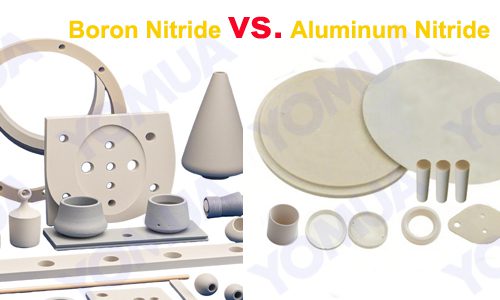Boron nitride (BN) and aluminum nitride (AlN) are both important non-oxide advanced ceramic materials, but they have key differences that make them suitable for distinct applications.

| Feature | Boron Nitride (BN) | Aluminum Nitride (AlN) |
|---|---|---|
| Structure | Hexagonal (h-BN) – layered, similar to graphite | Wurtzite |
| Thermal Conductivity | Lower than AlN | High (170-200 W/m·K) |
| Electrical Insulation | Excellent, superior to AlN | Excellent |
| Mechanical Strength | Good, but lower than AlN | High |
| Chemical Stability | Exceptionally high, resistant to corrosion | Good, but less than BN |
| Typical Applications | Lubricants, coatings, specialized electronics, composites | Electronic substrates for power devices, heat sinks |
| Cost | Generally higher | Generally lower |
| Other Properties | Lubricity, high-temperature stability, thermal shock resistance | High melting point, wear resistance |
| Future Development | Cost reduction, novel applications (composites, electronics) | Improved thermal conductivity, cost reduction, reliability |
Cost Comparison:
- BN: Generally more expensive than AlN. The cost can vary depending on the specific form and purity of the BN.
- AlN: Typically less expensive than BN, making it a more cost-effective choice for many applications.
Properties Comparison:
-
1. Structure and Composition: BN exists in several forms, with hexagonal boron nitride (h-BN) being the most common. H-BN has a layered structure similar to graphite. AlN, on the other hand, has a wurtzite crystal structure. This difference in structure significantly influences their properties.
2. Thermal Conductivity: AlN is known for its high thermal conductivity (170-200 W/m·K), making it ideal for heat dissipation in electronics. BN, particularly h-BN, has lower thermal conductivity than AlN.
3. Electrical Insulation: Both materials are excellent electrical insulators. However, BN is considered superior in this regard, possessing high dielectric strength and low electrical conductivity. AlN also insulates well but is often chosen when a combination of thermal conductivity and electrical insulation is needed.
4. Mechanical Strength: AlN generally exhibits higher mechanical strength than BN. This makes AlN better suited for structural applications. While BN has decent mechanical properties, it doesn’t match AlN’s strength.
5. Chemical Stability: BN is exceptionally chemically stable and resistant to corrosion, especially by acids and alkalis. It’s also unreactive with many metals and ceramics. AlN is also chemically stable, but not to the same extent as BN.
6. Applications: These differences lead to distinct applications:
- AlN: Used extensively in electronics as substrates for power devices due to its high thermal conductivity and mechanical strength.
- BN: Often used as a lubricant or coating due to its thermal stability and low friction. Its superior electrical insulation properties also find applications in specialized electronics.
Future Developments:
- BN: Research is focusing on developing new synthesis methods to reduce the cost of BN, particularly high-purity BN. Exploration of novel applications continues, including use in advanced composites, thermal management materials, and as a potential material for next-generation electronics due to its unique electronic and thermal properties. Nanomaterials based on BN, such as nanotubes and nanosheets, are also a promising area of research.
- AlN: Future developments in AlN are aimed at improving its thermal conductivity further, particularly for high-power electronics. Researchers are also working on enhancing the reliability and reducing the manufacturing costs of AlN substrates. Development of AlN-based ceramics and composites for specialized applications in aerospace and other industries is also an ongoing area of focus. Improving the control of the microstructure and purity of AlN is a key aspect of these advancements.
Conclusion:
In conclusion, both boron nitride (BN) and aluminum nitride (AlN) are crucial engineering ceramics with distinct properties that make them suitable for a wide range of applications. While both possess excellent electrical insulation, their differences in thermal conductivity, mechanical strength, chemical stability, and cost lead to their use in distinct fields.
AlN’s high thermal conductivity and robust mechanical properties make it the material of choice for demanding thermal management applications, particularly in the electronics industry. Its use as a substrate for high-power devices is well-established and continues to be a key area of development.
BN, with its superior electrical insulation, exceptional chemical inertness, lubricity, and high-temperature stability, finds applications in areas where these properties are paramount. From lubricants and coatings to specialized electronic components and advanced composites, BN plays a crucial role. Ongoing research into cost reduction and novel applications, especially in nanotechnology, promises to expand its use even further.
The choice between BN and AlN ultimately depends on the specific requirements of the application. Understanding their respective strengths and weaknesses is essential for selecting the optimal material for a given task. Continued research and development in both materials are expected to lead to even more advanced applications in the future, driving innovation in various technological sectors.